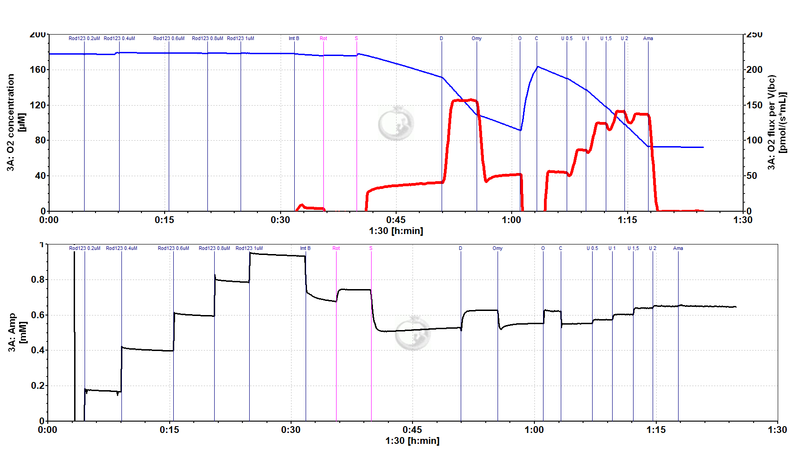Rhodamine 123: Difference between revisions
From Bioblast
No edit summary |
No edit summary |
||
| Line 8: | Line 8: | ||
__TOC__ | __TOC__ | ||
== Application in [[HRR]] == | == Application in [[HRR]] == | ||
Life Technologies, R302, 25 mg, store at -20 °C, FW=380.83 | Life Technologies, R302, 25 mg, store at -20 °C, FW=380.83 g/mol | ||
:::'''Preparation of 5 mM storage solution (dissolved in ethanol)''' | :::'''Preparation of 5 mM storage solution (dissolved in ethanol)''' | ||
::::# Weight 1.9 mg of Rh123 and dissolve in 1 mL ethanol; | ::::# Weight 1.9 mg of Rh123 and dissolve in 1 mL ethanol; | ||
| Line 21: | Line 21: | ||
== Signal and output == | == Signal and output == | ||
::::# Signal: The [[O2k-Fluo LED2-Module]] is operated through the Amperometric (Amp)-Channel of the O2k, with electric current (ampere [A]) as the primary signal. | ::::# Signal: The [[O2k-Fluo LED2-Module]] is operated through the Amperometric (Amp)-Channel of the O2k, with electric current (ampere [A]) as the primary signal. | ||
::::# Output: The focus of the output with Rh123 is on '''[[O2k signals and output| Type | ::::# Output: The focus of the output with Rh123 is on '''[[O2k signals and output| Type III]]''': Force, mt-membrane potential. | ||
== Rh123 with the [[O2k-FluoRespirometer]]: exploratory experiments == | == Rh123 with the [[O2k-FluoRespirometer]]: exploratory experiments == | ||
[[File:ImtB Rhodamine 123 S-Pathway.png |800px]] | [[File:ImtB Rhodamine 123 S-Pathway.png |800px]] | ||
:'''Figure 1. Coupling control and membrane potential.''' Brain isolated mitochondria were fueled with succinate ([[S-pathway control state]]) in presence of rotenone to inhibit complex I, displaying an accumulation of the dye according to their Δψ in the LEAK state (hyperpolarization, Amp record shows a decrease). After the addition of ADP, the dissipation of the proton motive force by the ATP synthase leads to a decrease of the Δψ (depolarization, Amp record shows an increase in the signal). The addition of the inhibitor for the ATP synthase oligomycin ([[Oligomycin| Omy]], high concentration) promotes to reach again LEAK state and, as consequence, hyperpolarization of the membrane (Amp record shows an increase in the signal). Finally, upon addition of the uncoupler CCCP, the Δψ collapses and the release of the Rhodamine123 from the mitochondria is associated with a decrease of fluorescence. Rhodamine 123 was used to measured the membrane potential and was calibrated before adding the sample in a step-wise titration (max. concentration 1µM). The optimum concentration of Rhodamine 123 to measure the membrane potential has to be tested in previous experiments. | |||
{{MitoPedia methods | {{MitoPedia methods | ||
Revision as of 10:28, 21 March 2019
Description
Rhodamine 123 is an extrinsic fluorophore and can be used as a probe to determine changes in mitochondrial membrane potential. Rh123 is a lipophilic cation that is accumulated by mitochondria in proportion to Δψmt. Using ethanol as the solvent, the excitation maximum is511 nm and the emission maximum is 534 nm.The recommended excitation and emission wavelengths in PBS are 488 and 515-575 nm, respectively (Sigma-Aldrich).
Abbreviation: Rh123
Template:Keywords Force and membrane potential
Application in HRR
Life Technologies, R302, 25 mg, store at -20 °C, FW=380.83 g/mol
- Preparation of 5 mM storage solution (dissolved in ethanol)
- Weight 1.9 mg of Rh123 and dissolve in 1 mL ethanol;
- Divide into 0.1 mL portions (use dark vials);
- Store at -20 °C.
- Preparation of 5 mM storage solution (dissolved in ethanol)
- Preparation of 0.2 mM stock solution
- Dilute a 100 µL aliquot 5 mM storage solution with 2400 µL ethanol to reach 2.5 mL final volume;
- Divide into 0.2 mL portions (use dark vials);
- Store at -20 °C.
- Preparation of 0.2 mM stock solution
Signal and output
- Signal: The O2k-Fluo LED2-Module is operated through the Amperometric (Amp)-Channel of the O2k, with electric current (ampere [A]) as the primary signal.
- Output: The focus of the output with Rh123 is on Type III: Force, mt-membrane potential.
Rh123 with the O2k-FluoRespirometer: exploratory experiments
- Figure 1. Coupling control and membrane potential. Brain isolated mitochondria were fueled with succinate (S-pathway control state) in presence of rotenone to inhibit complex I, displaying an accumulation of the dye according to their Δψ in the LEAK state (hyperpolarization, Amp record shows a decrease). After the addition of ADP, the dissipation of the proton motive force by the ATP synthase leads to a decrease of the Δψ (depolarization, Amp record shows an increase in the signal). The addition of the inhibitor for the ATP synthase oligomycin ( Omy, high concentration) promotes to reach again LEAK state and, as consequence, hyperpolarization of the membrane (Amp record shows an increase in the signal). Finally, upon addition of the uncoupler CCCP, the Δψ collapses and the release of the Rhodamine123 from the mitochondria is associated with a decrease of fluorescence. Rhodamine 123 was used to measured the membrane potential and was calibrated before adding the sample in a step-wise titration (max. concentration 1µM). The optimum concentration of Rhodamine 123 to measure the membrane potential has to be tested in previous experiments.
MitoPedia methods:
Fluorometry
Labels: MiParea: Respiration, Instruments;methods
HRR: Oxygraph-2k, O2k-Fluorometer, O2k-Protocol
O2k-MultiSensor

